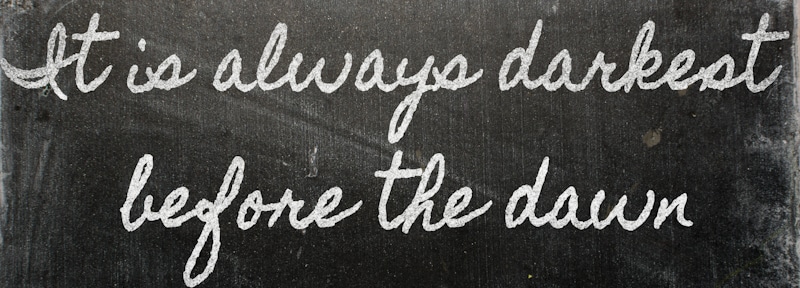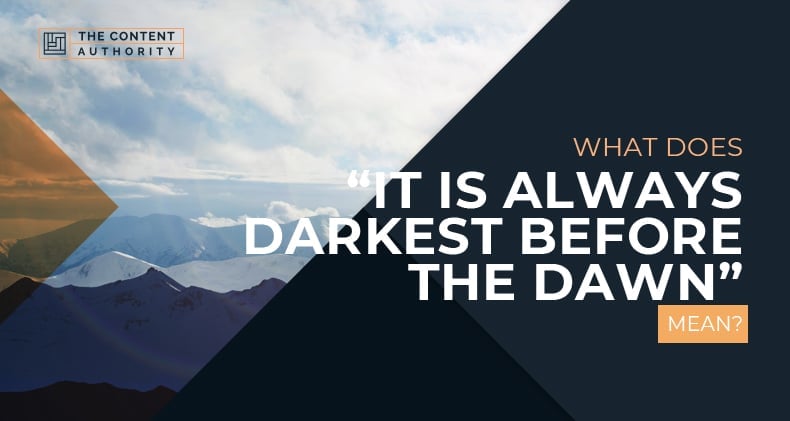There are a lot of idioms that are used in the English language today. One that you may commonly hear is “it is always darkest before dawn.” Have you wondered what it means?
The phrase “it is always darkest before the dawn” means things always seem worse before they get better. The English theologian and historian Thomas Fuller first said it. This was his way of saying that everything will improve at some time but we may have to go through something terrible first.

What the Phrase Means
We have all probably heard the saying “it is always darkest before the dawn.” People originally started saying this phrase because they believed that it was the darkest at this time. Then as soon as dawn breaks the first bit of light will start to shine. What this saying overlooks is the fact that it may take several more hours before the sun will actually rise and you will have daylight. Nevertheless, people still use this phrase to signify that no matter how bleak your circumstances may appear at the moment there is always a ray of hope there. In other words, things always seem to be the worst right before they start to get better. Keeping this meaning in mind, you should know that there is another saying that people frequently use that has a similar meaning, “every dog has his day.”
Where the Phrase Originated
Now that you can understand what this phrase means, you may find yourself wondering where it originated. It is actually a proverb which means that it’s a short saying that states a general piece of advice. One of the places that you’ll frequently come across this proverb is in self-help manuals and books discussing talk therapy. These books have been using the proverb, “it’s always darkest before the dawn” for quite a while. They use it when they’re trying to say that a person may be at their lowest point. This is something that actually dates back to the 1700s. However, this isn’t where the proverb itself originated.
Prior to finding this proverb being frequently used in self-help books we hear the English theologian and historian Thomas Fuller use it. In fact, many people think that he’s the first person to have used it in his religious travelogue which was entitled “A Pisgah-Sight Of Palestine And The Confines Thereof.” In 1650 he wrote, “It is always darkest just before the Day dawneth.”
Where this proverb actually originated is unknown. Nobody is certain if Fuller may have been quoting someone else. However, this proverb continued in use – even throughout the modern-day. For instance, in 1858, Samuel Lover attributed this proverb to the songs and ballads of the Irish in which it’s written, “Remember that the darkest hour of all is the hour before day.” Many Irish peasants would frequently quote this proverb when they were faced with adverse circumstances in which they needed a bit of hope.
Truth Behind the Saying
Although the proverb “it is always darkest before the dawn” is very inspirational in nature, some people have brought the truthfulness of the saying into question when it’s taken literally. In other words, is it true that it’s always the darkest before the dawn?
When this question is addressed from a scientific perspective you will discover that it’s actually darkest at midnight. This is because midnight is the time that is at the midpoint between dusk (sundown) and dawn (sunrise). At this time the sun is situated on the opposite side of the earth from where it’s being observed that night. In other words, the point is located 180 degrees away from the sun. This is especially true when there’s a new moon because then there isn’t any reflective light that’s being given off by the moon.
See Also: Dusk vs Dawn and Dusk vs Sunset
Make sure you understand that when you’re talking about dawn and sunrise you’re talking about two different things. Dawn is defined as the time when you can first detect some light in the sky. On the other hand, sunrise is defined as the time when the sun finally reaches the horizon. The time that’s between dawn and sunrise is known as twilight. So, if you don’t think about the vague light you get from the moon or other celestial bodies then the darkest part of the night is actually that which is after dusk and before dawn – twilight.
Something that makes this even more confusing is the fact that there are actually three different definitions of what dawn is. These include:
- When you’re discussing astronomy dawn is defined as the point when it’s possible to first start detecting light in the sky. At this point in time, the light is actually located 18° below the horizon.
- When you’re talking to sailors about navigation dawn is defined as the point in time when it’s possible to properly see the horizon. At this time sailors would be able to start distinguishing some objects that were located on the horizon. The light itself would be located 12° below the horizon.
- When you talk to the “average” person, they define dawn as the point in time where there’s enough light to do activities outside without needing to use artificial lighting. In other words, the light itself is located only 6° below the horizon.
Regardless of how you define dawn, the saying “it is always darkest before the dawn” still has the same meaning: things always look the most hopeless right before they change for the better.
Theology Behind the Saying
Since the proverb “it is always darkest before the dawn” is a proverb that was used by the theologian Thomas Fuller some people have wondered where in the Bible they can find this quote. What may be surprising to learn is that this quote isn’t in the Bible at all. Nevertheless, the quote has still been used in a lot of different sermons over the years. You’ll also find it being used in various books and movies too. As was noted earlier, nobody is for certain where this quote originated. Nevertheless, a lot of people do tend to agree that it was probably authored by the English theologian and historian Thomas Fuller (1608 – 1661).

Another Similar Saying
Another saying that’s similar to the proverb, “it’s always darkest before the dawn” is “the night is always darkest just before the dawn.” While this proverb can also be found throughout history, nobody specific is quoted as having first said it. Some people believe that it’s a quote from the movie The Dark Knight while others believe that it’s a Spanish proverb – a notion that was asserted in “The Alchemist” by Paulo Coelho.
One thing we do know for sure is that Thomas Fuller was the first person to have committed this notion to print. In 1650 he wrote “A Pisgah-Sight Of Palestine And The Confines Thereof” in which we find the line, “It is always darkest just before the Day dawneth.”
Throughout the years this phrase has been said in numerous different ways. For instance, there’s the saying “if you hit rock bottom you can only go up.” Herein the word “darkest” is replaced by the words “rock bottom” while the word “dawn” is replaced by the words “go up” (alluding to the sun rising). This phrase is used to mean that “things are getting better.” In this case, “It’s always darkest before dawn” means “Once things have completely gone awry, they can only get better”.
Example Sentences
Now that you have a much better understanding of what this phrase means and how it originated, you may want to learn how you can use it in your everyday speech and writing. Here are a few examples to help you get started with this:
- Although your father died and life seems bleak now, “it’s always darkest before the dawn.”
- While your daughter may be hooked on drugs now you must always remember that “it’s always darkest before the dawn.”
- Death may be knocking at your loved one’s doorstep but “it’s always darkest before the dawn.”
- This tragedy was unforeseen but that doesn’t mean that it has to drag you down. Remember, “it’s always darkest before the dawn.”
- Things may seem horrible right now but remember “it’s always darkest before the dawn.”

Conclusion
There are bound to be times in life when we are faced with problems or challenges that appear hopeless at the time. It may seem like whatever happens at this time the consequences will all be negative. It’s at these times that we want to give up, grow depressed, or simply accept a bad fate. However, we should remember, “it’s always darkest before the dawn.” In other words, things may seem hopeless, never-ending, or extremely dark right now. You may feel like there’s no solution to your problem or no way out. However, the dawn will come and something positive that you didn’t expect will happen to lift your spirits and show you that there really is a way out after all.
Shawn Manaher is the founder and CEO of The Content Authority. He’s one part content manager, one part writing ninja organizer, and two parts leader of top content creators. You don’t even want to know what he calls pancakes.

